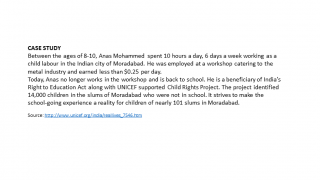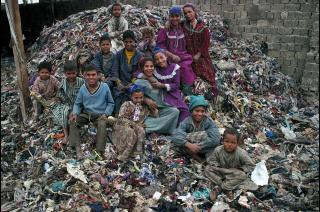All the children in the world = 2.2 billion
Childhood is the time between birth and becoming an adult. It is a time to learn, to play and be safe. But it can also be a time of vulnerability. In many societies, children are exposed to problems such as malnutrition, disease, poverty and inequality. They are also likely to suffer disproportionately during armed conflict and humanitarian disasters.
- 400 million children worldwide live in extreme poverty according to a 2013 World Bank report. That means they live on $1.25 or less a day, equivalent to less than £1.
- In the UK, 3.5 million children - or more than one in four children - lived in poverty in 2014. In Tower Hamlets, one of London boroughs, 49 percent of children were estimated to be living in poverty in 2013.
- Globally, about 45 percent of deaths among children under age five are caused by undernutrition according to a 2013 report from UNICEF.
- It is estimated that 300,000 child soldiers are engaged in some 30 armed conflicts around the world. Children are used as combatants, messengers, porters and cooks. Some are forced to have sex.
Children require special protection and support if they are to fulfil their potential. Healthy, educated children become healthy, well-informed adults: people who can create better lives for themselves, their own children, their communities, their countries and the wider world. Looking after the welfare of children is an investment in a better future for us all.
Growing up can be difficult
Children are important members of society. Their participation at home, in school and in their wider communities is vital. But children, particularly in the world’s poorest communities, tend to be the most deprived in terms of health and opportunities. They can also find it more difficult to take action to ensure that their basic needs and rights are met.
Education enables children to develop their abilities and to access other human rights, for example, the right to work and to political participation. Yet factors such as the cost of education; lack of facilities like pens, books, teachers and classrooms; the pressure to work and support their families; and social attitudes can hold children back from going to school.
- 57 million children were not enrolled in school in 2013.
Health is affected by several issues, including access to health care, clean water, protection against diseases, nutritious food and a safe environment.
- According to UNICEF some 6.3 million children under five years died in 2013, mostly from preventable causes, their fundamental right to survive and develop unrealised
- Across the globe, every day, over 1,400 children die from diseases directly linked to unsafe water or a lack of basic sanitation facilities[4]
Work is a reality for many children in the world. Working as a child isn’t necessarily bad – many children in the UK and other countries work to support their family by looking after a relative, helping out in the family business or by seeking paid employment. But it is important that children work in safe conditions, that they receive adequate wages, are above the minimum age of employment and that they have opportunities to access education. Unfortunately, millions of children around the world are forced to work.
- The International Labour Organization (ILO) estimates that 168 million children are currently involved in child labour that violates international standards, including some of the worst forms of child labour, such as slavery or trafficking.
Protecting and empowering children
The United Nations (UN) works to promote the welfare of children worldwide. Founded in 1945 in the aftermath of the Second World War, the UN is an international organisation made up of 193 countries that strives to achieve international peace, development and human rights.
One of the most important aspects of the UN’s work is the protection and empowerment of children. The UN recognises that children have rights too and that they require special protection. In 1989, it drew up a treaty called the Convention on the Rights of the Child, the first international legal document containing a set of children’s rights and standards. These include the right to education, to shelter and an adequate standard of living, and the right to be free from torture and abuse. The right of children to participate in decisions affecting their lives is also included.
Only two countries – the United States and South Sudan – have not signed the Convention. All other countries including the UK – have agreed to make its contents a reality in their territories.
What else does the UN do?
The UN’s children’s organisation, UNICEF, supports governments in fulfilling the provisions contained in the Convention. Helping the world's children survive and flourish is a core UNICEF activity, and improving health, safety and access to education is central to that. In the years since the Convention was adopted, UNICEF has led the UN’s efforts to improve the lives of children, with some amazing successes:
- UNICEF has helped to distribute vaccines to over 40 per cent of children in developing countries[5]
- The annual number of under-five deaths has been halved, from around 12.5 million[6] in 1990 to 6.6 million in 2012[7]
- Gender gaps in primary-school enrolment are shrinking across the developing world.[8]
UNICEF also works for children in the UK, helping to combat problems such as child poverty and encouraging young people to learn about global issues such as climate change.
What next?
The challenge for the UN – and for us all – is to build on the progress achieved and continue to work together to reach those children who are still being denied their rights to development, protection and participation. By celebrating Universal Children’s Day, people all over the world can contribute to protecting and empowering the world’s children.


